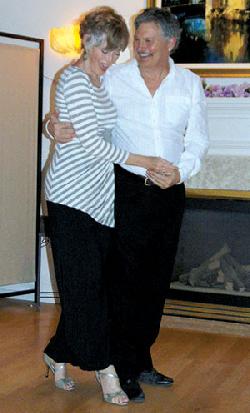 |
| Splash photo by Staci Lehman |
Tango instructors Deborah Goetze and Philip Lechtenberg enjoy a turn on Lechtenberg’s living-room-turned-dance-floor.
|
|
|
|
|
Profiles: 'Tango is my mistress'
3/30/2015 4:07:01 PM
By Staci Lehman
Splash Contributor
Philip Lechtenberg blames his tango obsession on a woman. It was 2007 when the woman in question asked him to dance at a milonga - a tango dance party. Soon after, another woman invited him to a local salsa night. While those women are long gone, that was the start of a lasting love affair. And a new name.
Philip became known as Felipe el Aleman ("Philip the German" in Spanish) for his love of all things Latin, especially tango. "Felipe" isn't the only one enamored with the dance. The Spokane/Coeur d'Alene "tango community" boasts almost 100 people who dance on a regular basis. While many are committed to the tango lifestyle - not just the dance but the music, the movement and the sense of community - most haven't gone as far as Felipe and turned their living rooms into nightclubs.
"I thought I would meet a woman who would decorate it," Felipe says of the empty living room in his Liberty Lake home. "In 2007, I decided to open my home to others to introduce them to tango. Now tango is my mistress."
The 12-by-13 foot space with a beautiful hardwood floor is known as Felipe's Club Sin Rumbo, and is kept free of furniture for milongas and lessons. Because tango is danced in a close embrace, it's big enough to hold up to 16 couples at a time.
"The best thing about tango is the hugs," said Deborah Goetze, another local tango instructor and Felipe's sometimes partner. The second thing, most people would agree, is the music. While most traditional tango music is in Spanish, Goetze says it is tied deeply and emotionally to the tango culture. "You may not understand the words but can pick up the emotion," she explained.
On a recent Saturday night, Felipe's Club Sin Rumbo had just a handful of couples and singles using it, but it was an enthusiastic crowd. Several of the dancers said what attracted them in the first place was the welcoming environment. According to tango etiquette, new dancers are never criticized.
Like Felipe, most discovered tango by attending a milonga with a friend, then returned on their own later. Falling in love with the dance is easy. But, for Felipe, getting it down was not.
"It was very painful learning," he said. "I went to all the local dances, but I would wait around in the parking lot for someone I knew to go in."
His skill - and fascination - with the dance grew. In 2008, friends invited him to Argentina, home of the tango. That trip led to many others to attend tango festivals and take lessons in places like Buenos Aires, Argentina; Bogota, Colombia; Istanbul, Turkey; Mexico and all over the United States.
No matter the travel or years of experience, tango dancers agree: You never master the dance. Most take hours of lessons, both at milongas and through private instructors. Felipe also imports experts from around the world to teach locally.
"If you commit to it, tango is more like a journey than a hobby," said David, one of the dancers at Felipe's Saturday night milonga.
While opening your home for dances seems like a thing of the past, hosting milongas in private homes is common in large cities and growing locally. The more involved area dancers take turns hosting the social nights. In-home milongas originally started in the 1930s and 40s when changes to political regimes in Argentina forced the dance underground.
If you'd rather go out, there are also dances at venues around the area. A milonga every Thursday night at the German American Society building in downtown Spokane starts with a beginners' class, taught by a volunteer instructor, followed by the actual milonga.
You won't just learn dance moves at these lessons. Felipe also teaches the etiquette of tango. For example, men and women sit on opposite sides of the room between dances. This way, dancers can see the signal that conveys someone is interested in dancing with them. The "cabeceo" is an invitation issued via body language, either though eye contact or a nod of the head toward a potential partner. It is a breach of etiquette to engage someone in deep conversation between dances as it may cause them to miss the cabeceo, which began as a way to save face if a dancer is not interested.
"If she is interested, she will nod back or smile," Felipe said. "If not, she'll go back to looking at her iPhone."
Etiquette also dictates that you commit for the three- or four-song set, or "tanda," of music if you respond to the cabeceo.
"If a dancer says, ‘thank you,' and sits down after just one or two songs, that means you smell funny or your partner no longer wants to dance with you," Felipe explained. "It's a way of being dismissed."
Felipe recommends prospective tango dancers start with lessons at the German American Society building at 25 W. 3rd Ave. in Spokane. They start at 7 p.m. and are followed by the milonga until 10 p.m. Admission is $5.
You can also get information on area tango lessons and the dance itself on the Inland Northwest Tango website at www.in-tango.com.
But be warned.
"Be careful if you're interested because it's addictive!" Felipe said.
• • •
Profiles: Philip Lechtenberg
Age
61
Also known as
Felipe el Aleman ("Philip the German")
Career
Retired
If you could go anywhere in the world
Berlin, to dance tango of course
Unique project
"Felipe" is translating the lyrics to all his favorite tango songs from Spanish into English and compiling them into a series of six books he plans to sell at tango festivals and online.
Advertisement

|
